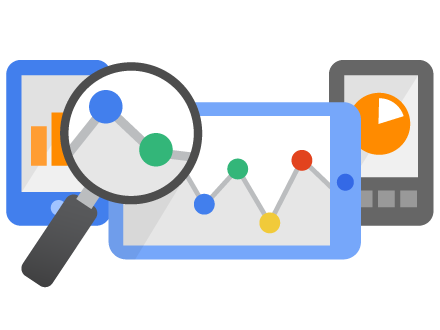As a data focussed agency, Google Analytics is our bread and butter. It is the starting point for most of our work - it helps inform strategy, provides results, and can be used to suggest which advanced data sets to look into first.
Because of our love for Analytics, we’ve decided to share with you 7 key metrics that you have to be measuring and why.
1. Channel
The channel overview is one of the first set of metrics we will analyse when looking into a Google Analytics account for the first time. This view can be found under the acquisition menu, and shows you your visits, % of new visits, bounce rate, pages/visit, visit duration, goal conversion rate, and goal value by acquisition channel grouping. These typically include organic search, paid search, social, direct, referral, display and email.
By seeing the performance of each of these metrics at a glance you can quickly analyse the marketing mix at a base level, as well as using this view to track overall channel performance. By looking at the traffic level and goal conversion rate of each channel you can identify where there are potential problems, and where focus should be given first. A possible practical change from this data could be amending landing pages for certain channels based on the bounce rate for instance.
2. Organic Landing Pages
Now that your organic keywords are mostly hidden under (not provided) it is nigh on impossible to accurately analyse your organic traffic. One way however is to look at the landing pages that organic search is delivering traffic to. This allows you to have a rough idea of the types of keywords sending traffic based on the landing pages being chosen. This will be helpful for some sites, whereas other sites which have less content may be struggling to draw many results from the landing pages.
The landing pages data for organic traffic can be found under Acquisition > Keywords > Organic and then by clicking the ‘Landing Page’ primary dimension tab.
3. Exit Pages
Exit pages show you the last page that users looked at before exiting your site. Normally your homepage will be at the top of this as users bounce and so on, however the pages and posts that come next provide you with some insight into how visitors are viewing your content.
On our site for instance, blog posts dominate the exit page section. This is naturally as people come, read our news and leave as they aren’t necessarily in need of our services at that point. However, there is one particularly page that ranks highly in the exit pages amongst the blog posts. This shows me that this page needs optimising to improve the flow - either by directing people to more information, or a contact page.
Exit pages can be found under Behaviour > Site Content > Exit Pages.
4. Goals
Goals can be found under Conversions > Goals > Overview. On this page you can see each of your goals broken down by traffic source/medium, you can see your overall goal conversion rate, goal value and goal completions.
This allows you to quickly see which goals are performing well, and which poorly. Looking at it against traffic source/medium quickly gives you insight into marketing channel performance. The goal screen is one of the first we check, firstly to ensure all the goals are tracking properly, and secondly to see where things may need conversion rate optimisation work.
5. Conversion Paths
The assisted conversion data allows you to see multi channel funnel groupings, allowing you to more accurately measure the value of a traffic channel. For instance, display traffic will often look bad in terms of goal conversions as this uses the traditional last click conversion method. This view allows you to also see assisted conversions, which is where a channel has brought a user to the website, before they have converted where the last click was from a different traffic channel. This is often the case in the case of display and social for instance as users find out about the site through these channels and become aware of what’s on offer, before having a need and coming back through search.
Assisted conversions can be found under Conversions > Multi-Channel Funnels > Assisted Conversions. When analysing marketing efforts this is a key screen as last click conversion attribution makes some channels seem a lot less important than they are in your overall marketing mix.
6. Mobile & Devices Overview
The mobile screen allows you to see visits, bounce rate, pages per visit, and conversions as a comparison between desktop, mobile and tablet traffic. The devices view gives you the same data but broken down by exact device (Apple iPhone, HTC M7 One etc). These are both found under Audience > Mobile.
These show you your performance across the different device types and specific devices, allowing you to find opportunities to optimise your pages for different browser types if needed based on bounce rate and more importantly, conversion rate.
7. New vs. Returning
The new vs. returning metric can be found under Audience > Behaviour. This allows you to see the proportion of your traffic that is returning vs. visiting the site for the first time. This gives you an idea of the stickiness of your site, as well as the value of each kind of user. If your conversion rate is much higher for new visitors than returning visitors then this may indicate a retention issue, or the true value of your new customer offers for instance.
Conclusion
In reality, most of the metrics in Google Analytics are well worth paying attention to, but the 7 above are a selection of our favourites. If you’re new to Google Analytics then these 7 metrics are a strong starting point for beginning to understand your traffic, but remember to explore all there is to offer within the menus on the left hand side and see which metrics hold the most value for your business.
Ben Harper
Latest posts by Ben Harper (see all)
- How Effective Are Facebook Ads? - July 4, 2014
- What The World Cup Means For Advertisers - June 4, 2014
- Are you a digital marketing rockstar? - May 22, 2014


